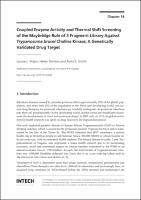Chapter 14 Coupled Enzyme Activity and Thermal Shift Screening of the Maybridge Rule of 3 Fragment Library Against Trypanosoma brucei Choline Kinase; A Genetically Validated Drug Target
Author(s)
Denton, Helen
Major, Louise L.
Smith, Terry K.
Major, Louise L.
Denton, Helen
Smith, Terry K.
Collection
WellcomeLanguage
EnglishAbstract
In this study we interrogate 630 compounds of the Maybridge Rule of 3 Fragment Library for compounds that interact with, and inhibit TbCK. The Maybridge Rule of 3 Fragment Library is a small collection of quantifiable diverse, pharmacophoric rich, chemical entities that comply with the following criteria; MW ≤ 300, cLogP ≤ 3, H-Bond Acceptors ≤ 3, H-Bond Donors ≤ 3, Rotatable bonds (Flexibility Index) ≤ 3, Polar Surface Area ≤ 60 Å2 and aqueous solubility ≥ 1 mM using LogS and high purity (≥ 95%). Comparisons between two different screening methods, a coupled enzyme activity assay and differential scanning fluorimetry, has allowed identification of compounds that interact and inhibit the T. brucei choline kinase, several of which possess selective trypanocidal activity. Screening of a comparatively small fragment library by two different screening methods has allowed identification of several compounds that interact with and inhibit TbCK, a genetically validated drug target against African sleeping sickness. Some of the inhibitory fragments were also selectively trypanocidal, considering these are relatively simple molecules with no optimization, finding low μΜ inhibitors is very encouraging. Moreover some of the morphological phenotypes of these trypanocidal compounds include cell-cycle arrests similar to those observed for the TbCK conditional knockout grown under permissive conditions.
Book
Drug DiscoveryKeywords
pharmacology; toxicology; pharmacology; toxicology; Assay; Enzyme; Molar concentration; Protein; Thermal shift assay; Trypanosoma bruceiDOI
10.5772/52668OCN
1030819386Publisher
InTechOpenPublisher website
https://www.intechopen.com/Publication date and place
2013Grantor
Classification
Pharmacology


 Download
Download